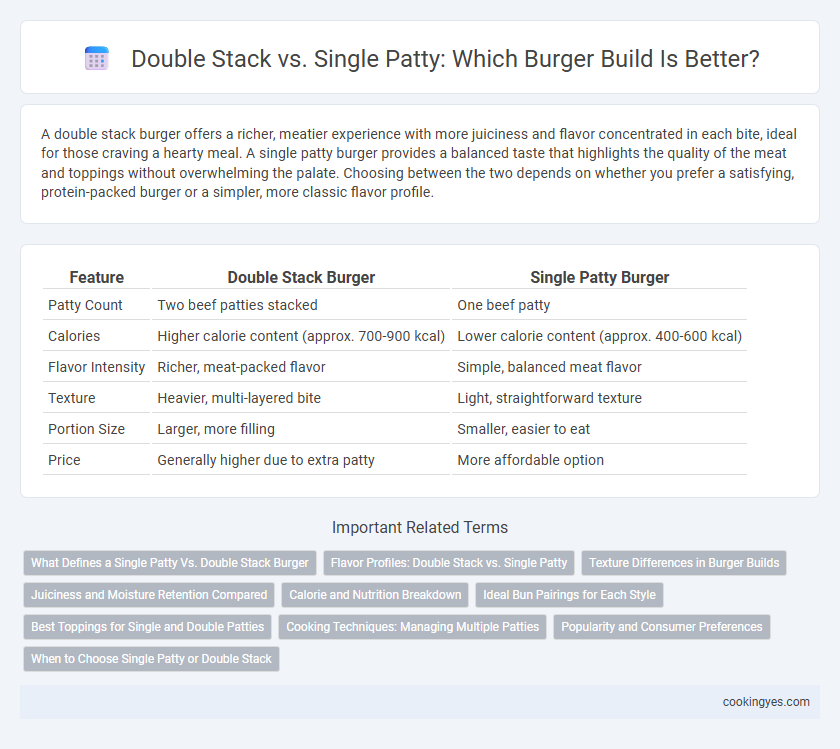A double stack burger offers a richer, meatier experience with more juiciness and flavor concentrated in each bite, ideal for those craving a hearty meal. A single patty burger provides a balanced taste that highlights the quality of the meat and toppings without overwhelming the palate. Choosing between the two depends on whether you prefer a satisfying, protein-packed burger or a simpler, more classic flavor profile.
Table of Comparison
| Feature | Double Stack Burger | Single Patty Burger |
|---|---|---|
| Patty Count | Two beef patties stacked | One beef patty |
| Calories | Higher calorie content (approx. 700-900 kcal) | Lower calorie content (approx. 400-600 kcal) |
| Flavor Intensity | Richer, meat-packed flavor | Simple, balanced meat flavor |
| Texture | Heavier, multi-layered bite | Light, straightforward texture |
| Portion Size | Larger, more filling | Smaller, easier to eat |
| Price | Generally higher due to extra patty | More affordable option |
What Defines a Single Patty Vs. Double Stack Burger
A single patty burger features one layer of ground beef typically weighing between 4 to 6 ounces, emphasizing simplicity and balanced flavor. A double stack burger doubles the meat portion with two separate patties, often stacked with cheese and toppings to create a taller, more indulgent sandwich. The defining difference lies in the number of meat layers, which directly impacts the burger's size, juiciness, and overall taste complexity.
Flavor Profiles: Double Stack vs. Single Patty
Double stack burgers offer a richer, more complex flavor profile by combining two layers of beef, which enhances juiciness and beefiness with each bite. Single patty burgers provide a cleaner, more focused taste that highlights the quality and seasoning of the meat without overwhelming other ingredients. The choice between double stack and single patty affects overall flavor intensity and balance, catering to preferences for boldness versus simplicity.
Texture Differences in Burger Builds
Double stack burgers deliver a more complex texture by combining crispy, caramelized edges with juicy, tender interior patties, creating a satisfying contrast in every bite. Single patty burgers prioritize a uniform texture, highlighting the meat's juiciness and allowing toppings and sauces to stand out without overwhelming the palate. The interplay between the multiple layers of a double stack produces a denser, more varied mouthfeel compared to the simpler, more balanced texture of a single patty burger.
Juiciness and Moisture Retention Compared
Double stack burgers retain more juiciness due to the increased surface area of two patties, which helps trap moisture inside each layer. Single patty burgers tend to lose moisture faster because the larger single piece cooks more evenly but can dry out quicker. The extra fat content and juices released between double patties enhance overall moisture retention and deliver a juicier bite.
Calorie and Nutrition Breakdown
A double stack burger typically contains around 700-900 calories, doubling the protein content to approximately 40-50 grams while significantly increasing fat to 40-60 grams, compared to a single patty burger's 350-450 calories with 20-25 grams of protein and 20-30 grams of fat. The higher calorie and fat load in double stack burgers can impact daily macronutrient distribution, making them less suitable for calorie-restricted diets but beneficial for those needing increased protein intake. Single patty burgers offer a more balanced option with fewer calories and saturated fats, supporting weight management and heart health goals.
Ideal Bun Pairings for Each Style
Double stack burgers pair best with sturdy buns such as brioche or ciabatta, offering enough support to hold the multiple patties without becoming soggy. Single patty burgers work well with classic potato or sesame seed buns, providing a balanced softness that complements the thinner meat layer. Selecting the right bun enhances the overall texture and flavor, ensuring the build remains stable and enjoyable with each bite.
Best Toppings for Single and Double Patties
Double stack burgers benefit from bold toppings like sharp cheddar, crispy bacon, and caramelized onions to balance the richness of two beef patties, while creamy sauces like spicy mayo add moisture without overwhelming the layers. Single patty burgers pair well with simpler toppings such as fresh lettuce, ripe tomato slices, and mild cheddar, allowing the beef flavor to remain the star. Pickles and grilled mushrooms enhance both versions by adding texture and umami without cluttering the flavor profile.
Cooking Techniques: Managing Multiple Patties
Cooking multiple patties in a double stack burger demands precise heat control to ensure even cooking without drying out the meat. Using a lower temperature and longer cook time helps achieve a juicy interior while properly melting cheese between layers. Flipping patties individually and layering them after cooking preserves texture and prevents overcooking common in stacked single patty builds.
Popularity and Consumer Preferences
Double stack burgers have gained significant popularity due to their satisfying size and enhanced flavor, appealing to consumers seeking a hearty meal. Single patty burgers remain favored for their simplicity, ease of eating, and balanced taste, attracting those who prefer a lighter option. Consumer preferences often vary by region and occasion, with double stacks dominating fast-food menus, while single patties are common in casual dining and gourmet burger establishments.
When to Choose Single Patty or Double Stack
Choosing a single patty burger is ideal when prioritizing a balanced bite with more focus on toppings and bun texture, ensuring each ingredient's flavor remains distinct. Opting for a double stack suits those seeking a hearty, protein-packed meal with a juicier, meat-forward experience that satisfies bigger appetites. Consider portion control and flavor intensity, as single patties offer simplicity while double stacks deliver a robust, layered taste profile.
Double stack vs Single patty for burger build Infographic

 cookingyes.com
cookingyes.com